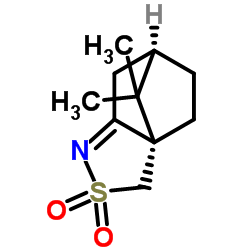127184-05-8
| Name | (+)-(8,8-Dichlorocamphorylsulfonyl)oxaziridine |
|---|---|
| Synonyms |
()-3,3-Dichloro-2,N-epoxy-exo-10,2-bornanesultam
[2R-(2|A,4a|A,7|A,8aR*)]-8,8-Dichlorotetrahydro-9,9-dimethyl-4H-4a,7-methanooxazirino[3,2-i][2,1]benzisothiazole 3,3-Dioxide (+)-((8,8-Dichlorocamphoryl)sulfonyl)oxaziridine |
| Density | 1.687 g/cm3 |
|---|---|
| Boiling Point | 390.471ºC at 760 mmHg |
| Melting Point | 181-186ºC |
| Molecular Formula | C10H13Cl2NO3S |
| Molecular Weight | 298.18600 |
| Flash Point | 189.95ºC |
| Exact Mass | 296.99900 |
| PSA | 58.06000 |
| LogP | 2.90210 |
| Index of Refraction | 1.648 |
Synonym:(+)-3,3-Dichloro-2,N-epoxy-exo-10,2-bornanesulta Section 2 - COMPOSITION, INFORMATION ON INGREDIENTS
Risk Phrases: Section 3 - HAZARDS IDENTIFICATION EMERGENCY OVERVIEW
The toxicological properties of this material have not been fully investigated. Potential Health Effects Eye: May cause eye irritation. Skin: May cause skin irritation. Ingestion: The toxicological properties of this substance have not been fully investigated. Inhalation: May cause respiratory tract irritation. The toxicological properties of this substance have not been fully investigated. Chronic: Not available. Section 4 - FIRST AID MEASURES Eyes: Flush eyes with plenty of water for at least 15 minutes, occasionally lifting the upper and lower lids. Get medical aid. Skin: Get medical aid. Flush skin with plenty of soap and water for at least 15 minutes while removing contaminated clothing and shoes. Ingestion: Get medical aid. Wash mouth out with water. Inhalation: Remove from exposure to fresh air immediately. If not breathing, give artificial respiration. If breathing is difficult, give oxygen. Get medical aid. Notes to Physician: Treat symptomatically and supportively. Section 5 - FIRE FIGHTING MEASURES General Information: As in any fire, wear a self-contained breathing apparatus in pressure-demand, MSHA/NIOSH (approved or equivalent), and full protective gear. Extinguishing Media: In case of fire use water spray, dry chemical, carbon dioxide, or chemical foam. Autoignition Temperature: Not available. Flash Point: Not available. NFPA Rating: Not published. Explosion Limits, Lower: Not available. Upper: Not available. Section 6 - ACCIDENTAL RELEASE MEASURES General Information: Use proper personal protective equipment as indicated in Section 8. Spills/Leaks: Vacuum or sweep up material and place into a suitable disposal container. Section 7 - HANDLING and STORAGE Handling: Avoid breathing dust, vapor, mist, or gas. Avoid contact with skin and eyes. Storage: Store in a cool, dry place. Do not store in direct sunlight. Store in a tightly closed container. Keep under a nitrogen blanket. Refrigerator (approx 4C). Section 8 - EXPOSURE CONTROLS, PERSONAL PROTECTION Engineering Controls: Use adequate ventilation to keep airborne concentrations low. Personal Protective Equipment Eyes: Wear appropriate protective eyeglasses or chemical safety goggles as described by OSHA's eye and face protection regulations in 29 CFR 1910.133. Skin: Wear appropriate protective gloves to prevent skin exposure. Clothing: Wear appropriate protective clothing to prevent skin exposure. Respirators: Follow the OSHA respirator regulations found in 29CFR 1910.134. Always use a NIOSH-approved respirator when necessary. Section 9 - PHYSICAL AND CHEMICAL PROPERTIES Physical State: Solid Appearance: Not available. Odor: Not available. pH: Not available. Vapor Pressure: Not available. Vapor Density: Not available. Evaporation Rate: Not available. Viscosity: Not available. Boiling Point: Not available. Freezing/Melting Point: 180 - 181 deg C Decomposition Temperature: Not available. Solubility: Not available. Specific Gravity/Density: Not available. Molecular Formula: C10H13Cl2NO3S Molecular Weight: 298.18 Section 10 - STABILITY AND REACTIVITY Chemical Stability: Stable under normal temperatures and pressures. Conditions to Avoid: Incompatible materials, dust generation. Incompatibilities with Other Materials: Strong oxidizing agents. Hazardous Decomposition Products: Hydrogen chloride, nitrogen oxides, carbon monoxide, oxides of sulfur, carbon dioxide. Hazardous Polymerization: Has not been reported Section 11 - TOXICOLOGICAL INFORMATION RTECS#: CAS# 127184-05-8 unlisted. LD50/LC50: Not available. Carcinogenicity: (+)-[(8,8-Dichlorocamphoryl)sulfonyl]oxaziridine - Not listed by ACGIH, IARC, NIOSH, NTP, or OSHA. See actual entry in RTECS for complete information. Section 12 - ECOLOGICAL INFORMATION For further information, contact Fisher Scientific. Section 13 - DISPOSAL CONSIDERATIONS Dispose of in a manner consistent with federal, state, and local regulations. Section 14 - TRANSPORT INFORMATION CDG/CPL IMO Not regulated as a hazardous material. IATA Not regulated as a hazardous material. RID/ADR Not regulated as a hazardous material. Canadian TDG No information available. Section 15 - REGULATORY INFORMATION European/International Regulations European Labeling in Accordance with EC Directives Hazard Symbols: Not available. Risk Phrases: Safety Phrases: S 24/25 Avoid contact with skin and eyes. WGK (Water Danger/Protection) CAS# 127184-05-8: Canada None of the chemicals in this product are listed on the DSL/NDSL list. WHMIS: Not available. CAS# 127184-05-8 is not listed on Canada's Ingredient Disclosure List. Exposure Limits US FEDERAL TSCA CAS# 127184-05-8 is not listed on the TSCA inventory. It is for research and development use only. SECTION 16 - ADDITIONAL INFORMATION N/A |
| Hazard Codes | Xn |
|---|---|
| Safety Phrases | S22-S24/25 |
| RIDADR | UN 1479 |
| Packaging Group | III |
| Hazard Class | 5.1 |
|
~90% 
127184-05-8 |
| Literature: Davis, Franklin A.; Weismiller, Michael C. Journal of Organic Chemistry, 1990 , vol. 55, # 12 p. 3715 - 3717 |
|
~% 
127184-05-8 |
| Literature: Tetrahedron Letters, , vol. 33, # 2 p. 161 - 164 |
| Precursor 2 | |
|---|---|
| DownStream 0 | |


